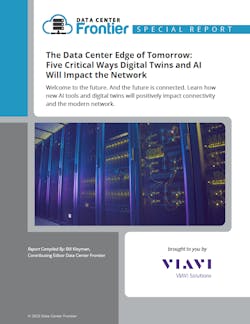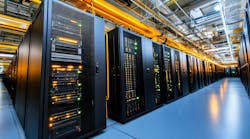Digital Twins and AI in the Network: Top 5 Network Modernization Considerations
We continue our article series on the positive impact that digital twins and AI will have on connectivity and the modern network. This week, we'll dive into some key network modernization considerations to help you keep a competitive edge.
The rise of the cloud computing model and the steadily advancing adoption of 5G is accelerating digital transformation in almost every area of our lives.
To keep pace with this rapid change, it is no surprise that data centers are undergoing a major reboot — from design to scale to how they are powered, organized, and run. The rise of the cloud computing model has also redefined the data center market. This has seen growth and consolidation in equal measure. The key players are building bigger data centers in locations that suit their customers’ needs, which has enabled a raft of efficiencies.
The telecom industry, meanwhile, has traditionally favored a long-game approach to data center deployment, characterized by meticulous planning and comprehensive pre-deployment testing to ensure five nines (99.999%) availability and a data center lifespan of 10+ years.
The rollout of 5G is placing unprecedented strain on data center infrastructure worldwide, with the introduction of new services, IoT verticals, and the intelligent edge that powers them. Increased end-to-end network complexity challenges the old deployment schedules while raising the bar for performance, efficiency, and reliability.
For hyperscale leaders, this created a new challenge where they needed to ensure that they could keep pace with massive scale requirements and new network designs. Further, the intricacies of distributed, disaggregated, and cloudified 5G networks push data center design to the limit.
Balancing costs is one challenge: Data center costs are rising just as their scale and complexity continue to escalate. There are also the performance pitfalls surrounding 5G: virtualized RAN, massive MIMO, and antenna beamforming complicate the performance testing requirements within hyperscalers, introducing new spectrum analysis, demodulation, and SLA challenges.
Overcoming these challenges requires end-to-end network slicing to be orchestrated seamlessly for each unique vertical — in other words, hyperscalers need to have a seamless, holistic approach to network management. Hyperscalers require a next- generation approach to network test, assurance, and optimization a step change from outdated, traditional data centers with siloed network management to deliver fully automated and programmable network slicing and edge computing. Critical 5G IoT use cases leave no margin for error with respect to network performance and reliability.
Network innovation in the age of persistent connectivity
Let’s explore some ways hyperscale and data center leaders are innovating their solutions to support new connectivity requirements.
1. The orchestration of connectivity. Connectivity must become seamless if data center and hyperscale leaders strive to support some of the most latency-sensitive applications. Data center monitoring and orchestration tools are increasingly agile, automated, and virtual to support the new data center infrastructure For example, Internet Content Providers (ICPs), whose traditional focus has been on content, are waking up to the benefits of comprehensive deployment, management, and optimization techniques to push their existing infrastructure further, deliver on data speeds, maintain uptime and head off issues before problems arise.
Rigorous tests and measurements can help ICPs manage change and speed network buildouts. Forexample, test process orchestration and automated inspection practices alleviate the headaches of integrating new technologies into the data center. As data centers upgrade their equipment to enable speeds of 400G and 800G and beyond, ICPs need a way of ensuring reliability.
Data center monitoring and orchestration tools will be more critical than ever to keep pace with these changes. Test and measurement tools must be agile, automated, and virtual to support data center infrastructure and achieve the volume and speed of traffic flow required to power on-demand computing and content delivery.
2. Supporting new devices and connections. For IoT to reach its full potential, yet more interconnect is required to speed up the transport and processing of generated data. For instance, autonomous cars and eHealth are just two instances that demand a zero-tolerance approach to latency, as every nanosecond holds the potential for a life-or-death situation. To support these emerging requirements, operators can leverage tools that build an elastic test bed that can be scaled across multiple test locations, connections, and devices — this will be key as operators begin testing core elements across several disaggregated cloud locations. It is the ideal tool for service providers as they look to roll out 5G core networks across both public and private cloud environments to support new devices and connections.
3. Leveraging tools to find challenges and opportunities (test and optimize). There is no time to waste when working with low-latency edge solutions. As more services go online, expectations around performance and availability will continue to rise. Developers talk in terms of customer experience (CX). Network operators obsess over subscriber quality of experience (QoE).
Similarly, retailers worry about the consumer experience. For ICPs, certainty is paramount. Test and measurement (T&M) are critical in keeping the
IoT running 24/7/365, and the stakes could not be higher. It may come as a surprise that many ICPs do not routinely test their data center interconnects. Faster troubleshooting is a considerable advantage of routine testing, but possibly an even more significant benefit is the power of prevention. In addition to ongoing maintenance, ensuring optimal performance of new, upgraded systems before turn-up is always critical.
In the era of IoT, edge computing is relieving the pressure on data centers. For ICPs, keeping on top of the data center is no longer enough. ICPs must have the assurance that storage and transport capacity is performing at optimal levels. And if they’re not, they must rely on tools that show them how to optimize those essential connections.
4. Sustainability in networks and using testing tools to improve efficiency and reduce your carbon footprint. Even though data center growth has risen, growth in power consumption is flattening out. However, as the appetite for data keeps growing, it will be far from easy for data centers, hyperscale, and ICPs to constrain their power consumption.
Today, there are powerful tools that digital infrastructure leaders can utilize to combat spiraling energy bills. For instance, ensuring data center interconnects are running efficiently and delivering anticipated speeds can be achieved as part of a rigorous monitoring and testing program. To prepare for increasing DCI speeds, data center engineers need to run testing on 400G interfaces to pinpoint potential problems and troubleshoot them early. While some have reacted nimbly to the corresponding growth in power consumption with innovative data center designs, the challenge is far from solved. Data center and infrastructure leaders must remain open to emerging solutions that impact their carbon footprint.
5. Working with digital twins and AI in the network. The next iteration of network intelligence and testing will revolve around digital twins and AI solutions in the network. First, what is a digital twin?
A digital twin is a virtual or digital representation of a physical asset, object, or manufacturing process. Its intended purpose is continuously learning and providing data insights around vast operations.
The latest research from Gartner indicates that the digital twin market will cross the chasm in 2026 to reach $183 billion in revenue by 2031, with composite digital twins presenting the most significant opportunity. To remain competitive, product leaders must build ecosystems and libraries of prebuilt functions and vertical market templates.
You can leverage information, data sciences, and robust systems to enable digital twins of supply chain management, factory processes, and inventory management. You can also leverage digital twins for some of the most advanced network testing in the industry. So, for example, your digital twin, coupled with the data and the applications that support it, can help automate the deployment of network slices and further enable management, network assurance, and troubleshooting.
Download the full report, The Data Center Edge of Tomorrow: Five Critical Ways Digital Twins and AI Will Impact the Network, featuring VIAVI, to learn more. Working with digital twins and AI helps infrastructure leaders revolutionize their network design and connectivity approach. We'll continue the conversation around digital twins and AI in the network in our next article.
About the Author



